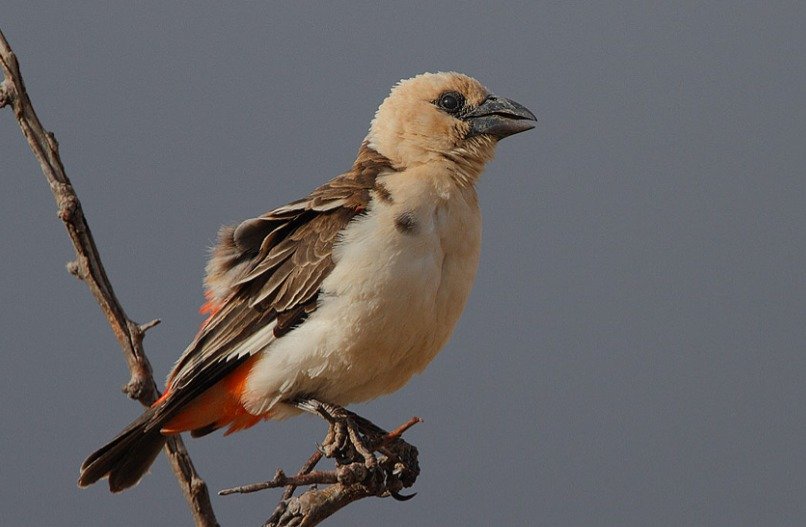
Meet the White-headed Buffalo Weaver:
 “White-headed Buffalo Weaver” by Stefan Haag is licensed under CC BY 4.0.
“White-headed Buffalo Weaver” by Stefan Haag is licensed under CC BY 4.0.
Description : The white-headed buffalo weaver , known scientifically as Dinemellia dinemelli , belongs to the Ploceidae family of passerine birds. The white-headed buffalo weaver, measuring 170–190 mm (6.7–7.5 in) long and weighing 57–85 g (2.0–3.0 oz), exhibits distinctive characteristics. It displays a white head and underparts, contrasting with a striking orange-red rump and undercoverts. Its thighs are dark brown and on the wings there are thin white bands, more pronounced when the wings are extended.
 “White Headed Buffalo Weaver” by jdnx is licensed under CC BY 2.0.
“White Headed Buffalo Weaver” by jdnx is licensed under CC BY 2.0.
Both males and females share similar plumage, with a conical black beak. In particular, D. d. dinemelli has a brown tail, while D. d. Boehmi sports a black tail.
There are two recognized subspecies of this bird.
 “Dinemellia dinemelli -Buffalo Springs National Park, Kenya-8 (1)” by Steve Garvie of Dunfermline, Fife, Scotland is licensed under CC BY-SA 2.0.
“Dinemellia dinemelli -Buffalo Springs National Park, Kenya-8 (1)” by Steve Garvie of Dunfermline, Fife, Scotland is licensed under CC BY-SA 2.0.
This species is native to several East African countries, including Ethiopia, Kenya, Somalia, Sudan, Tanzania and Uganda. It thrives in habitats such as savannas, scrublands, dry scrublands and acacia thickets.
 “White-headed Buffalo Weaver” by Rod Waddington is licensed under CC BY-SA 2.0.
“White-headed Buffalo Weaver” by Rod Waddington is licensed under CC BY-SA 2.0.
It has earned its peculiar name from its habit of following African buffaloes and feasting on the insects their movements awaken. White-headed buffalo weavers exhibit gregarious behavior, foraging for insects on the ground, particularly beetles and butterflies, as well as fruits and seeds. They often feed in groups of 3 to 6 individuals.
 “_GTL9226-CR3_DxO_DeepPRIME” by gary_leavens is licensed under CC BY-SA 2.0.
“_GTL9226-CR3_DxO_DeepPRIME” by gary_leavens is licensed under CC BY-SA 2.0.
Breeding pairs maintain monogamous relationships and build nests together. Nest construction is influenced by rainfall patterns and local conditions, resulting in oval-shaped nests with multiple rooms. The outer layers of the nests have defensive thorny branches. These birds protect their nests and vocalize as a form of defense against intruders. These confrontations are usually non-lethal and revolve around vocal displays. The breeding season is determined by rainfall and regional variations. The nests are composed of materials pressed together, not intricately woven. They typically have a short downward-facing inlet tube, situated at a height of approximately 2 to 4 meters (6.6 to 13.1 feet) above the ground. Soft materials line the inside of the nest. These birds often build several nests in a single large tree, which are sometimes used by other bird species, such as the African pygmy falcon, instead of building their own nests. Female white-headed buffalo weavers incubate 3 to 5 eggs, which are grayish to pale blue with red, brown and olive markings, over a period of 11 to 14 days. Both parents share the responsibility of feeding the chicks.
 “Dinemellia dinemelli -Buffalo Springs National Park, Kenya-8” by Steve Garvie of Dunfermline, Fife, Scotland is licensed under CC BY-SA 2.0.
“Dinemellia dinemelli -Buffalo Springs National Park, Kenya-8” by Steve Garvie of Dunfermline, Fife, Scotland is licensed under CC BY-SA 2.0.
These birds produce various calls, some of which resemble parrot sounds, such as “skwieeer” and “kiiyerr.” Breeding and resting sites witness the addition of variable sounds, including laughter and whistles. Males put on elaborate displays for females by flaunting their white wing spots and orange-red tail coverts. They are also known to perch in trees, sometimes hanging upside down and creating considerable noise.
 “File: White-headed buffalo weaver Dinemellia dinemelli 2000px.jpg” by Photo by and (C) 2007 Derek Ramsey (Ram-Man) is licensed under CC BY-SA 2.5.
“File: White-headed buffalo weaver Dinemellia dinemelli 2000px.jpg” by Photo by and (C) 2007 Derek Ramsey (Ram-Man) is licensed under CC BY-SA 2.5.
This bird is considered of Least Concern on the IUCN Red List.
 “The white-headed buffalo weaver Dinemellia dinemelli in Tanzania 3697 Nevit” by Nevit Dilmen (discussion) is licensed under CC BY-SA 3.0.
“The white-headed buffalo weaver Dinemellia dinemelli in Tanzania 3697 Nevit” by Nevit Dilmen (discussion) is licensed under CC BY-SA 3.0.
Listen to this bird’s song below:


